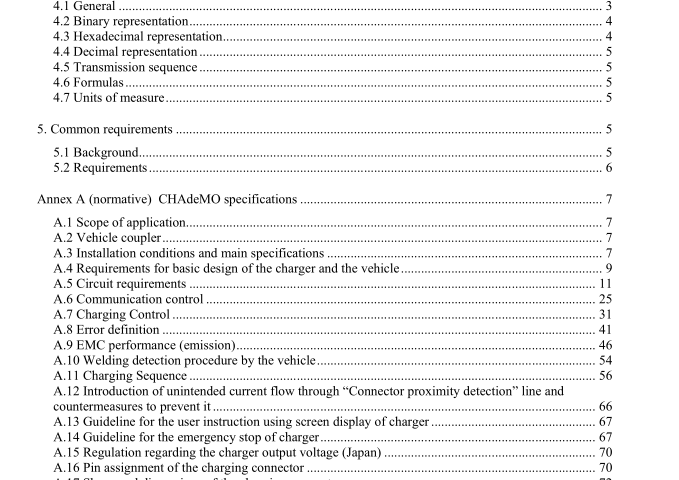IEEE 2030.1.1-2015 pdf download.IEEE Standard Technical Specifications of a DC Quick Charger for Use with Electric Vehicles
4.5 Transmission sequence
See Annex A, Annex B, and Annex C for their specific transmission sequence.
4.6 Formulas
Multiplication is represented as an “×” rather than as an “x” to avoid confusion with hexadecimal numbers
and variables.
4.7 Units of measure
Metric units are used.
Interpretations of common units of measure are as follows:
k (analog) = 1 000
K (digital) (e.g., kilobits) = 1024 (2 10 )
M (analog) = 1 000 000
M (digital) = 1 048 576 (2 20 )
n (analog) = 10 −9
Ω = Ohm
5. Common requirements
5.1 Background
In electric vehicles, the charger may be located on board or off board the vehicle. When the charger is on board the vehicle, it is developed for the specific type and size of the battery used in the vehicle. Simple ac voltage may be connected to the on-board charger’s power inlet. However, it may be difficult to charge large batteries quickly using common residential ac voltage and current. If the charger is off board the vehicle, it requires communication with the battery control system. This communication protocol may be different by vehicle model, so off-board chargers can be designed to accommodate multiple technologies. The benefit is that dc chargers can provide more charging energy to the vehicle, which can reduce charge time (“quick charging”).
Clause 5 describes the common requirements pertaining to collaborative actions between electric vehicles and quick chargers.
Annex A and/or Annex B shall be used to implement these charging systems.
5.2 Requirements
These requirements are “common” requirements for the specifications in Annex A and Annex B.
a) General
1) Device shall be able to indicate to the user the status of the charging process and take corrective actions if required.
2) Both the charger and the vehicle shall be equipped with a means to confirm they stay physically and/or electrically connected with each other during charging.
3) The charger shall be equipped with a means to stop charging in the case that communication between the vehicle and the charger (via the communications interface) is interrupted.
4) When the protective conductor between the charger and the vehicle is disconnected, the charger shall stop charging within 10 s.
5) The charger shall be able to detect loss of isolation, short circuit, and earth faults.
6) The charger shall be equipped with an overvoltage protection function.
7) The system shall be designed so that a level of voltage that is dangerous to the human body shall not be applied on the charging connector when the connector is not connected to the vehicle.
8) The system shall be designed to prevent users from touching electrically energized parts on the vehicle and the charger.
9) The charger shall be equipped with a means of earth leakage current detection and automatic disconnection to help prevent electric shock.
10) The charger or charging connector shall be equipped with measures (e.g., plastic cap on connector power terminals) to reduce the risk of contact with exposed live parts as a measure against remaining electric charge on the charging connector.
11) The charger shall be equipped with a means of protection against overload and short circuit in the ac main circuit or internal circuit of the charger.
12) The charging system shall be designed so that the voltage level between any accessible conductive parts, including charging cable and charging connector, and any grounding parts decreases to less than 60 V within 1 s or less, after connector removal from station or vehicle.
b) Communications A data communications interface shall be used to transmit parameters required for charging control. The charger and vehicle shal
c) Outdoor/indoor conductive charging
The charger shall be designed to endure the following environmental conditions:
1) The charger enclosure shall have a rating of IP33 or higher.
2) Ambient temperature (outdoor): −25 °C to 40 °C.
3) Ambient temperature (indoor): −5 °C to 40 °C.
4) Ambient humidity: 5% to 95%.
5) Altitude: Charger shall work between the atmospheric pressures of 860 hPa and 1060 hPa.IEEE 2030.1.1 pdf download.IEEE 2030.1.1-2015 pdf download
IEEE 2030.1.1-2015 pdf download

Leave a Reply